June 5, 2020 feature
Manipulating metals for adaptive camouflage
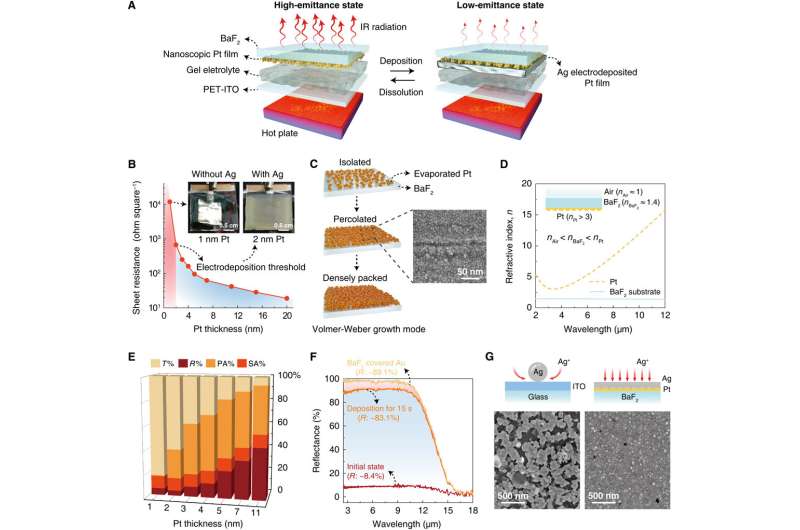
Many species have naturally evolved remarkable strategies to visually adapt to their environments for protection and predation. Researchers have studied adaptive camouflaging in the infrared (IR) spectrum, although the method is highly challenging to develop in the lab. In a new report now published on Science Advances, Mingyang Li and a research team at the National University of Defense Technology in China, developed adaptive thermal camouflage devices that bridged the optical and radiative properties of nanoscopic platinum (Pt) and silver (Ag) electro-deposited Pt films. The metal-based devices maintained large, uniform, and consistent IR tunabilities in the mid-wave IR (MWIR) and long-wave IR (LWIR) atmospheric transmission windows (ATWs). The team multiplexed and enlarged the devices, allowing flexibility for camouflaging capabilities. The technology is advantageous across a variety of camouflage platforms and in many thermal radiation management technologies.
Recent years have seen extensive research efforts to control the infrared (IR) features of objects for camouflage in the IR spectrum. To achieve this goal, scientists must precisely control the radiant heat emitted from an object to match the background. Based on the Stefan-Boltzmann law, the radiant heat of an object is proportional to the fourth power of its absolute temperature and the emittance of the surface. For dynamic control of the temperature or thermal emittance of the object, scientists offer microfluidic networks and thermoelectric systems as possible approaches to maintain adaptive thermal camouflage. Inspired by the multiple optical and radiative properties of metals, Li et al. reported on nanoscopic platinum (Pt) film-based reversible silver (Ag) electrodeposition (RSE) devices for excellent adaptive thermal camouflage capabilities.
Since nanoscopic platinum films have high IR absorption and partial IR transmission, this could be transformed to absorption via the IR-absorbing gel electrolyte layer in the setup. Applying the deposition voltage in the system allowed gradual electrodeposition of silver on the nanoscopic platinum films, gradually converting the IR absorption and transmission to IR reflection to enable low-emittance states from the devices. Nanoscopic Pt films could not be dissolved, therefore, they allowed multiple cycles of Ag deposition and dissolution, in order to switch between high and low-emittance states for many cycles. Li et al. developed diverse devices with multiple structural coatings, rough and flexible substrates to form multiplexed formats to expand the camouflaging scenarios.
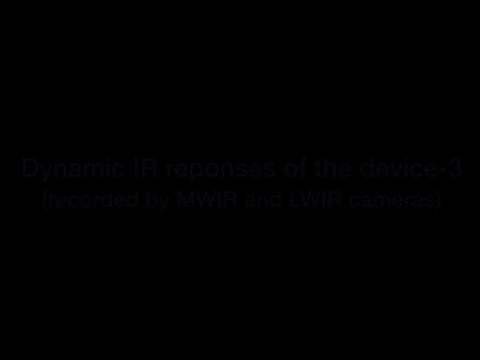
To explore the regulation of IR on the metal-based devices, the team first studied the electrical properties of the nanoscopic Pt films. They examined the spectral responses of the film, where increasing the Pt thickness showed huge decreases in IR transmittance to indicate that the IR absorption dominated the spectral response of the thin films. The scientists further examined the potential ranges of IR modulation and the cycling stability of the nanoscopic platinum films in a three-electrode reversible silver electrodeposition (RSE) film. Due to the energy favorable interface between Ag and Pt, the electrodeposited Ag film showed comparatively more uniform, coherent and fine-grained morphologies on the 3 nm Pt film. This feature allowed the scientists to convert the nanoscopic Pt film to a high IR reflective film in a short period of time. The nearly identical potentiostatic cycling curves in the system confirmed their ability to perform stable and reversible electrodeposition on the nanoscopic Pt films.
To assess the IR performance of the assembled devices with varying Pt thicknesses, Li et al. attached them on to a 500C hot plate and recorded their real-time MWIR (mid-wave IR) and LWIR (long-wave IR) images. The team applied a negative voltage of 2.2 V to gradually electrodeposit Ag films on the Pt surface, as the apparent temperature of these devices gradually decreased. When the researchers applied a positive voltage of 0.8 V thereafter, the electrodeposited Ag film could be completely dissolved into the electrolyte, and turned to their initial states to indicate the reversibility of the devices. The device could function steadily for up to 350 fully reversible cycles to confirm their stability and reversibility for adaptive thermal camouflage.
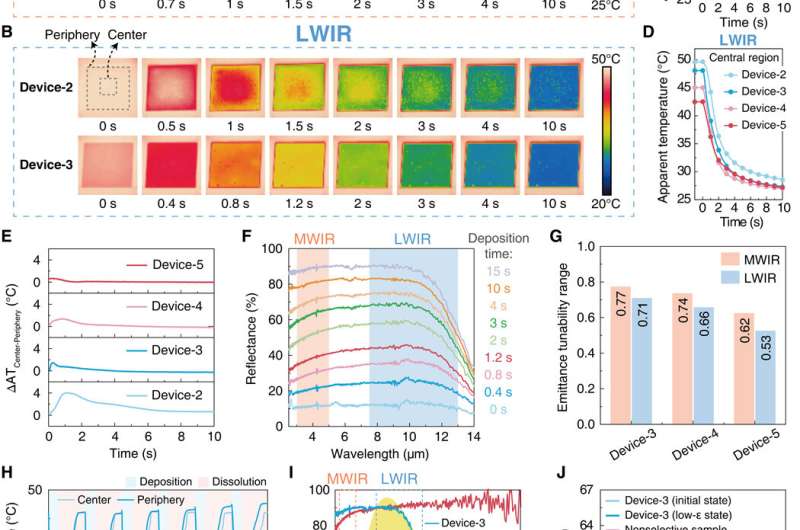
To multiplex and enlarge the device, Li et al. constructed a three-by-three multiplexed IR switchable array and an enlarged independent device. By controlling the combined electrodeposition time of its independent pixels, the scientists generated the letters "N", "U", "D", and "T" with different temperatures as LWIR images on the array. The work showed the adaptability of the complex background and large-area feasibility of the adaptive systems. The team next expanded the camouflaging scenario of the metal-based dynamic IR modulation mechanism on rough and flexible devices. During the work they replaced polished barium fluoride (BaF2) substrates with rough versions and used polypropylene (PP) films to deposit the nanoscopic Pt films. Due to the micron-scale roughness of BaF2 and poor wettability of the PP film, the team noted the requirement for thicker Pt films to form physically connected and electrically conductive films. The rough BaF2-based device diffusely reflected the outside thermal matrix in the setup and suppressed its own IR radiation to effectively reduce the impact from the external environment. The rough and flexible adaptive variants developed in the work highlighted the multi-substrate compatibility of the metal-based IR modulation mechanism, which expanded the camouflaging scenarios of the device.
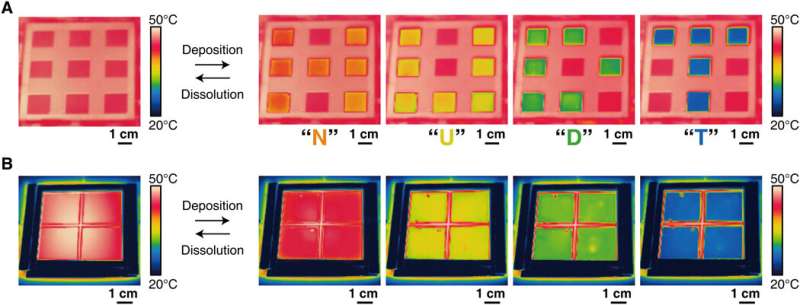
Li et al. then combined the devices with structural color coatings to improve their visible compatibility so as to prevent their visible detection in daytime. For this, they used a series of visible-wavelength-scale, thick chromium oxide (Cr2O3) layers between the BaF2 substrate and nanoscopic Pt films. Upon depositing different thicknesses of Cr2O3 layers, due to their thin-film interference effects in the visible spectrum, the "decorated" devices displayed various colors. The scientists noted the structural colors to shift from relatively dark to more pronounced colors in the setup. The Cr2O3 layers only generated colors in the visible spectrum and therefore exerted little influence on the IR performance of the devices. The results showed the possibility of integrating simple optical designs into the adaptive systems for visible compatibility, making the devices more difficult to detect in the daytime.
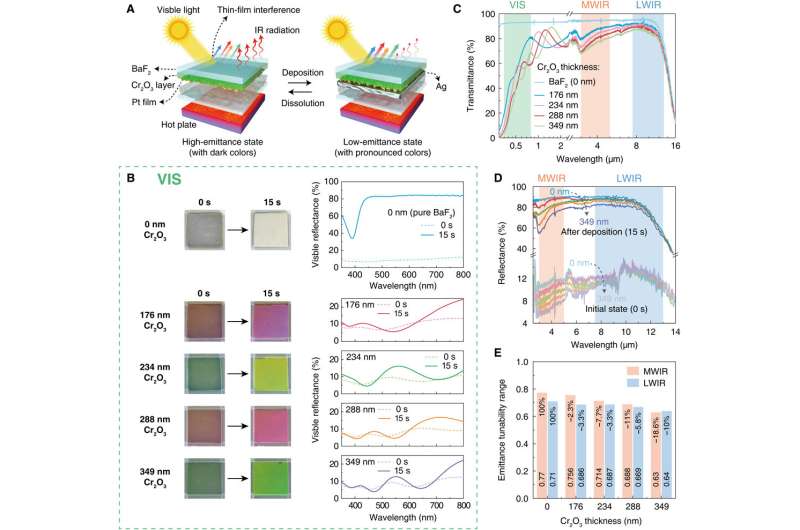
In this way, Mingyang Li and colleagues developed adaptive camouflage devices by reversibly depositing silver on nanoscopic platinum films. The devices showed large, uniform, and consistent IR tunabilities in both mid-wave IR and longwave IR atmospheric transmission windows. The scientists easily multiplexed the devices by patterning nanoscopic Pt films or by adding conductive grids for complex background adaptability and large-area flexibility. The team achieved visible compatibility by adding a series of visible-wavelength-scale-thick Cr2O3 layers. The devices developed in this work can inspire the next generation of adaptive thermal camouflage platforms that rapidly and precisely control thermal radiation and camouflage in response to multispectral detection and adaptability to complex environments. These devices will have applications across thermal radiation management techniques including energy efficient buildings, thermoregulation clothes and in smart spacecrafts.
More information: Mingyang Li et al. Manipulating metals for adaptive thermal camouflage, Science Advances (2020). DOI: 10.1126/sciadv.aba3494
Chengyi Xu et al. Adaptive infrared-reflecting systems inspired by cephalopods, Science (2018). DOI: 10.1126/science.aar5191
Rinu Abraham Maniyara et al. Tunable plasmons in ultrathin metal films, Nature Photonics (2019). DOI: 10.1038/s41566-019-0366-x
Journal information: Science Advances , Science , Nature Photonics
© 2020 Science X Network




















